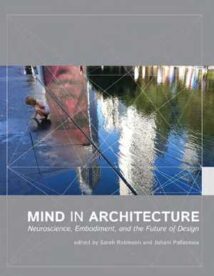نام کتاب: Mind In Architecture – Neuroscience, Embodiment, And The Future Of Design
نویسنده: Sarah Robinson و Juhani Pallasmaa
ویرایش: ۱
سال انتشار: ۲۰۱۵
کد ISBN کتاب: ۰۲۶۲۰۲۸۸۷۵, ۹۷۸۰۲۶۲۰۲۸۸۷۵,
فرمت: PDF
تعداد صفحه: ۲۵۹
حجم کتاب: ۸ مگابایت
کیفیت کتاب: OCR
انتشارات: The Mit Press
Description About Book Mind In Architecture – Neuroscience, Embodiment, And The Future Of Design From Amazon
Leading neuroscientists and architects explore how the built environment affects our behavior, thoughts, emotions, and well-being.
Although we spend more than ninety percent of our lives inside buildings, we understand very little about how the built environment affects our behavior, thoughts, emotions, and well-being. We are biological beings whose senses and neural systems have developed over millions of years; it stands to reason that research in the life sciences, particularly neuroscience, can offer compelling insights into the ways our buildings shape our interactions with the world. This expanded understanding can help architects design buildings that support both mind and body. In Mind in Architecture, leading thinkers from architecture and other disciplines, including neuroscience, cognitive science, psychiatry, and philosophy, explore what architecture and neuroscience can learn from each other. They offer historical context, examine the implications for current architectural practice and education, and imagine a neuroscientifically informed architecture of the future.
Architecture is late in discovering the richness of neuroscientific research. As scientists were finding evidence for the bodily basis of mind and meaning, architecture was caught up in convoluted cerebral games that denied emotional and bodily reality altogether. This volume maps the extraordinary opportunity that engagement with cutting-edge neuroscience offers present-day architects.
ContributorsThomas D. Albright, Michael Arbib, John Paul Eberhard, Melissa Farling, Vittorio Gallese, Alessandro Gattara, Mark L. Johnson, Harry Francis Mallgrave, Iain McGilchrist, Juhani Pallasmaa, Alberto Pérez-Gómez, Sarah Robinson
درباره کتاب Mind In Architecture – Neuroscience, Embodiment, And The Future Of Design ترجمه شده از گوگل
عصب شناسان و معماران پیشرو بررسی می کنند که چگونه محیط ساخته شده بر رفتار، افکار، احساسات و رفاه ما تأثیر می گذارد.
اگرچه ما بیش از نود درصد از عمر خود را در ساختمان ها می گذرانیم، اما درک بسیار کمی از نحوه تأثیر محیط ساخته شده بر رفتار، افکار، احساسات و رفاه ما داریم. ما موجوداتی بیولوژیکی هستیم که حواس و سیستم های عصبی آن ها در طی میلیون ها سال توسعه یافته اند. منطقی است که تحقیقات در علوم زیستی، به ویژه علوم اعصاب، می تواند بینش های قانع کننده ای را در مورد روش هایی که ساختمان های ما بر تعامل ما با جهان شکل می دهند، ارائه دهد. این درک گسترده می تواند به معماران کمک کند تا ساختمان هایی را طراحی کنند که هم از ذهن و هم از بدن پشتیبانی می کنند. در ذهن در معماری، متفکران برجسته از معماری و سایر رشتهها، از جمله علوم اعصاب، علوم شناختی، روانپزشکی و فلسفه، آنچه را که معماری و علوم اعصاب میتوانند از یکدیگر بیاموزند را کشف میکنند. آنها زمینه تاریخی را ارائه می دهند، پیامدهای مربوط به تمرین و آموزش معماری فعلی را بررسی می کنند و یک معماری آگاهانه از نظر علم اعصاب از آینده را تصور می کنند.
معماری در کشف غنای تحقیقات عصبشناسی دیر است. همانطور که دانشمندان در حال یافتن شواهدی برای اساس بدنی ذهن و معنا بودند، معماری درگیر بازی های مغزی پیچیده ای شد که واقعیت عاطفی و جسمانی را به کلی انکار می کرد. این جلد، فرصت خارقالعادهای را ترسیم میکند که تعامل با علوم اعصاب پیشرفته به معماران امروزی ارائه میدهد.
مشارکت کنندگان توماس دی. آلبرایت، مایکل آربیب، جان پل ابرهارد، ملیسا فارلینگ، ویتوریو گالیزه، الساندرو گاتارا، مارک ال جانسون، هری فرانسیس مالگریو، ایین مک گیلکریست، جوهانی پالاسما، آلبرتو پرز-گومز، سارا رابینسون
[box type=”info”]![]() جهت دسترسی به توضیحات این کتاب در Amazon اینجا کلیک کنید.
جهت دسترسی به توضیحات این کتاب در Amazon اینجا کلیک کنید.![]() در صورت خراب بودن لینک کتاب، در قسمت نظرات همین مطلب گزارش دهید.
در صورت خراب بودن لینک کتاب، در قسمت نظرات همین مطلب گزارش دهید.

